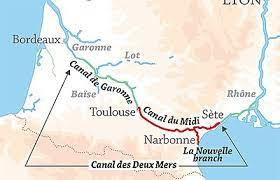What more idyllic escape from city-centre Toulouse than to potter up the Canal du Midi on foot, by bike or – best of all – in a boat? This post explains how ‘Europe’s biggest public works project since the fall of the Roman Empire’ came to be opened in 1681 and tells you what there is to see along its banks, just day-out distance from Toulouse. We recommend 3 books whose authors describe the delicious pleasures of exploring ‘la France profonde’ along the Canal du Midi. In Larry Habegger’s essay from Floating through France, she describes ‘motoring though an impressionist painting’ and drifting lazily through ‘a land of sunflowers, wheat fields, vineyards, ancient cities with red-tiled rooves, crumbling ruins wrapped in mystery.’
what is the canal du midi?



This 200 mile-long canal links the Atlantic Ocean at Bordeaux to the Mediterranean at Sète. It was built in the 17th century to save boat travellers a 3000-mile journey around the coast of Spain and is now designated a UNESCO World Heritage Site. It goes past Toulouse, making a saunter or boat trip along it an excellent idea for a day out from the city. It’s a shady, tree-lined haven, where life moves slowly, punctuated by the opening and closing of locks, the pottering of ducks and dragonflies and the passing of joggers and cyclists.
a little history



As early as the 8th century, Charlemagne dreamt of a canal short-cut for boats crossing southern France, and in the 17th century two men came together to make it happen: Louis XIV who paid for it and Pierre Paul Riquet who designed it. Travelling through the region as a tax collector, Riquet kept thinking about the idea until he could resist it no longer. Work began in 1666 with the building of a dam at St Férréol – which you can still visit today – to provide the water. The first section, from Toulouse to Castelnaudary followed and after 14 years of work it was complete, along with 63 locks and over 300 other ‘works’, such as bridges and lockkeeper’s houses.
There’s a monument to Riquet, who died just months before the canal was completed, in Port Lauragais about 50 kilometres from Toulouse. The American Thomas Jefferson, who travelled its length in 1787, waxed eloquent in his journal about the overhanging willows, the châteaux and the local wines, stating ‘of all the methods of travelling I ever tried, this is the pleasantest.’ The Canal du Midi brought a wave of prosperity to the area and at its highpoint in 1856, 111,000 metric tons of goods and a million passengers passed along it. Then came the railway, quicker and more convenient, and the canal’s long slow decline began, but in the late 20th century, it gradually became a tourist draw.
what to look out for



Many of the trees were planted in the late 1600s to provide shade and to prevent the water evaporating too quickly. They overhang the water, sometimes meeting in the middle, and forming lovely pale green canopy over the water. You’ll pass fields of sunflowers and see all manner of wildlife – cicadas, ducks, kingfishers, butterflies …. There is man-made beauty too, in the locks and stone bridges, where onlookers cluster to wave as you sail by and the lockkeepers’ cottages often have attractive coloured shutters and window-boxes of geraniums. The best-known lock is the Écluse de l’Océan, at the highest point, where there are view in both directions, to the Atlantic and the Mediterranean.
People along the canal are taking it slowly. You’ll see coloured barges with lace curtained windows pass by little huddles of pétanque players, clustered around the silver metal balls of the local sport, that version of bowls played in town and village squares all over France. You might come across a ‘Jute Nautique’, where opposing teams of rowers stand up on wooden planks laid across their boats and jostle to push each other into the water. The fastest modes of transport along the canal side are jogging and cycling.
3 books we recommend



Floating through France
Subtitled Life Between Locks on the Canal du Midi, this essay collection was put together by a group of American authors who travelled by boat down the Canal du Midi expressly to write about it. Many of their descriptions are idyllic, for example this one by Linda Watanabe McFerrin: ‘Mallards paddled peacefully in the leaf-green waters. Dragonflies skittered back and forth from canal to shore ….. a rooster was crowing and I could hear the bells of St Aubin.’
Cycling the Canal du Midi by Declan Lyons
This practical guide book divides the Canal into 5 sections of about 50 kilometres each, offering practical advice for cyclists on the weather, what to take, directions, etc and much fascinating historical background about places you can easily visit on short detours. It will take you to Carcassonne and Béziers and to tiny hamlets and hilltop villages to visit a host of châteaux and churches with stories and legends a-plenty to enliven your visit.
Notes from the Languedoc by Rupert Wright
This covers the region more generally – hello to its winemakers, oyster farmers and matadors, for example – but includes an enticing section on the Canal du Midi, about which the author writes: ‘The canal is lined by plane trees, each trunk an abstract painting. Ducks gather near the bridges. KIngfishers wait on the trees. Joggers run past you, cyclists disappear round bends.’
Listen to the POdcast
Reading suggestions
Floating through France by April Orcutt Life Between Locks on the Canal du Midi
Cycling the Canal du Midi by Declan Lyons
Notes from the Languedoc by Rupert Wright
links for this post
French Waterways Information on the Canal du Midi
St Ferréol Dam
L’Écluse de l’Océan
Previous Episode Art and Architecture in Toulouse
Next Episode Carcassonne and Toulouse Lautrec
Last Updated on November 5, 2025 by Marian Jones






